By Rona Kobell
Bay Journal
They stand in a tidy church graveyard in the main town of Ewell, adorned with U.S. flags and fresh wreaths, their shiny coatings a rebuke to the battering winds and rising tides.
The headstones bear the surnames of Smith Island: Bradshaw, Somers, Evans, Corbin. Hardy stock, all. Their descendants are still there, sticking it out on Maryland’s last inhabited offshore Chesapeake Bay island, while dozens of other isles have succumbed to the seas.
On a sunny June day, a new name joined: Johnsen. Though he’d only lived on Smith for five years and hadn’t been back in some time, Roy Johnsen declared that this weathered watermen’s island was where he wanted to be buried. An idiosyncratic veteran of two wars, a pilot, a sailor and a humanitarian, he felt most at home right here.
“When he would come to the island, no matter how long it had been, people would say, ‘Hey, Roy, welcome home,’” said Pastor Rick Edmund after he had dug the small grave for Johnsen’s cremated remains. “I’m sure that feeling is one of the reasons he wanted to be buried here.”
Pastoring for 17 years
The United Methodist Church re-assigned Edmund, 69, to a church near Allentown, Pa. A new pastor, Everett Landon, was to take over in late June.
Until this posting, Landon had been pastor of the Methodist congregations on Tilghman Island and in nearby Sherwood. His surname will be as familiar to Smith Islanders as those on the gravestones: He grew up in Rhodes Point. His wife, Carol Ann, is a Corbin.
Edmund, who came to ministry in his late 40s after a career in computer engineering, served not just as spiritual leader but also as a de facto mayor, emergency contact, concierge, mediator and all-around problem solver for an unincorporated community that has lost both land and population at an alarming rate in recent decades.
De facto mayor, emergency contact, concierge, mediator, lobbyist

Pastor Rick Edmund chats with Patty Corbin at Drum Point Market in Tylerton. Photo: Dave Harp, Bay Journal
During both Tropical Storm Isabel and Superstorm Sandy, he remained on the island and served as the official state contact. He testified before Congress on climate change and sea-level rise harming his community. Once, after giving the opening prayer at the Maryland General Assembly, Edmund remained in the State House to lobby for infrastructure funding for the island.
In 2002, when the Department of Natural Resources instituted crab restrictions that amounted to a 15% cut in harvest, it was Edmund who brought together the irate watermen of his congregation and the state’s natural resources secretary to work out a compromise. Edmund was also responsible for bringing U.S. Sen. Benjamin Cardin to the island and getting his help in securing $1 million for the installation of new water well for Rhodes Point. Cardin and his wife, Myrna, who are Jewish, attended Edmund’s church service.
“He’s probably one of the first pastors who really brought Smith Island and the world together,” said Elaine Eff, retired state folklorist, who met Edmund on the ferry boat on his first day as pastor 17 years ago. “He comes into a completely insular community, where people have done the things they have done that way forever, and he becomes the greatest docent for the island.”
A change of direction
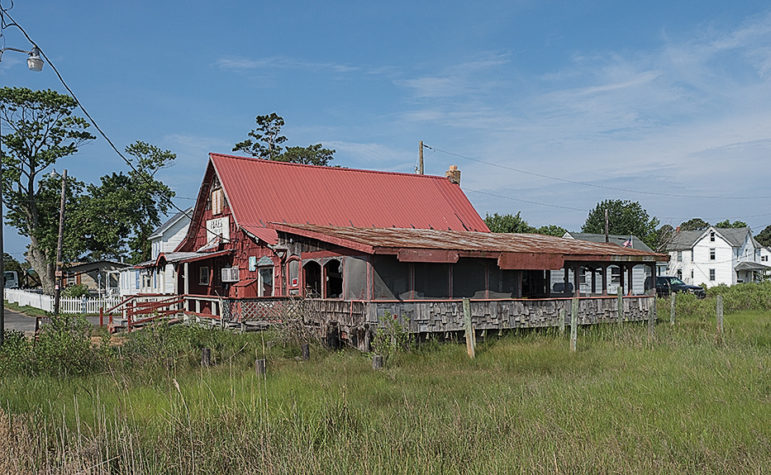
Ruke’s store and restaurant was once a favored meeting place for islanders and visitors alike. It closed two years ago. Photo: Dave Harp, Bay Journal
Edmund leaves an island in transition — from a vibrant watermen’s community to a quieter tourist destination. When he came to Smith Island 17 years ago, the population was around 300, with most men crabbing in the summers and oystering in the winters. The population is about half of that now — the main post office delivers mail to 90 people in Ewell and Rhodes Point, and another 50 or so in Tylerton, which occupies its own tiny island on the east side of the island.
Tougher fishing regulations, the collapse of the oyster fishery, higher expenses and ever-greater uncertainty have driven many islanders to the mainland in search of more reliable jobs with benefits, such as at the state prison in Princess Anne.
In 2015, islanders lamented the closing of mainstay Ruke’s, the barnlike store and restaurant known for its crab cakes that drew locals and tourists alike. A year later, businessman Brian Murphy, founder of the Smith Island Baking Co., shuttered the bakery he had opened in Ewell in 2009 and consolidated cake-making operations in Crisfield, citing logistical issues.
Take the cake
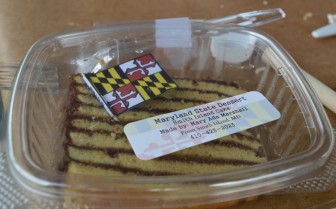 Though the islanders — descendants of 17th-century settlers from Cornwall, England — want to sustain the watermen’s culture, the island’s new hope relies on outsiders. Like many other places on the Bay, Smith Island is known for its seafood, though it also has one very specific culinary claim to fame: the 10-layer cake, which is just what the name suggests, ten layers of delicate, moist cake, each separated by a generous layer of frosting.
Though the islanders — descendants of 17th-century settlers from Cornwall, England — want to sustain the watermen’s culture, the island’s new hope relies on outsiders. Like many other places on the Bay, Smith Island is known for its seafood, though it also has one very specific culinary claim to fame: the 10-layer cake, which is just what the name suggests, ten layers of delicate, moist cake, each separated by a generous layer of frosting.
The origin of this multi-layer cake is unknown, though many credit the late Frances Kitching, an island innkeeper for three decades until her retirement in 1987. Kitching died in 2003, but not before establishing a national reputation for the traditional meals she prepared for visitors to her inn — which included New York Times food critics and celebrities like Sylvester Stallone (who is said to have arrived by helicopter with an entourage of 12). The 10-layer cake’s reputation got a boost in 2008, when the Maryland legislature named it the official state dessert.
The island has also attracted nature lovers, who kayak through its marshy guts and inlets; bird watchers, in particular, have loved watching snowy egrets and herons. Two islanders offer guided tours of a pelican rookery on an uninhabited island about 20 minutes away. “It’s like stepping into the pages of National Geographic magazine,” said Gretchen Maneval, a Towson resident who bought a home on Tylerton a few years ago and visits many weekends with her husband and two sons. “The kids can just frolic and play to their heart’s content.”
A vision plan

Smith Island from the air. Photo: Dave Harp, Bay Journal
Smith Island laid out its future goals in a state-funded “vision plan,” published in August 2015. In addition to tourism and watermen sustainability, the plan also called for reliable and expanded ferry service to the mainland and improved infrastructure to protect it from nuisance flooding.
It also sought to promote the island to newcomers and make them feel welcome and committed. Houses on Smith Island are inexpensive, and for good reason; more than a few people have bought fixer-uppers and then abandoned the projects, having learned the hard way how difficult it is to get supplies and contractors to an island without much of either.
The plan came in the wake of Superstorm Sandy in 2012. Like Isabel before it, Sandy barely touched Smith Island. So, residents were shocked when Maryland offered a buyout from a $2 million pot of funds for anyone who wanted to leave. The money came courtesy of the federal government, which has a policy not to rebuild in places likely to flood again. If Smith Islanders took the deal, they would receive the highest appraised value for their land. In exchange, the land would become “dead,” never to be built on again.
Most islanders were livid. Pastor Edmund helped them organize into Smith Island United so they could speak with one voice to reject the buyout.
“It was like, ‘circle the wagons, we’re not going to let anyone move us off this island,’?” Edmund recalled.
Breakwater, sewage plant projects
The result: Smith Island received close to $20 million in state and federal funds, much of it Superstorm Sandy relief money. About $9 million paid for a breakwater project to protect expansive marshes at Martin National Wildlife Refuge, while also shielding the island’s northern end from erosion. The U.S. Army Corps of Engineers estimates land loss to be 8–12 feet a year in some places. The Corps is readying work on a $9 million jetty project to protect Rhodes Point and improve navigation. Close to $1 million will fix the county docks at Ewell and Rhodes Point.
The island, at long last, is also getting a new $9.2 million sewage treatment plant. It will replace a deteriorating facility between Ewell and Rhodes Point and connect to Tylerton, allowing the retirement of a small, poorly functioning facility there.
Maryland has committed to fund it, in large part because both Tylerton and Ewell have repeatedly violated their permit limits, often discharging more fecal coliform and suspended solids than allowed.
The new plant will be built two feet higher than the current plant to account for expected sea-level rise. About $3.2 million will come from the Bay Restoration Fund, or flush tax; $2 million will come from the state revolving fund; and $4 million will come from the U.S. Department of Agriculture in the form of loans and grants, said Jay Apperson, spokesman for the Maryland Department of the Environment.
Untreated sewage flowing into the Bay
“If no action is taken to build the new plant to serve the island’s population, the Ewell plant’s continued corrosion will eventually lead to thousands of gallons of untreated sewage flowing to the Bay, Apperson said. “And Tylerton will continue to frequently violate its permit and the Clean Water Act.”
There’s no debate about the plant’s visibly poor condition. The Corps received funds to replace it in 2006; they upgraded the treatment wetlands in Tylerton, but when they began digging at the new site in Ewell, engineers discovered buried cars. They didn’t have the money to remediate, and had to abandon the project, said the Corps’ Kevin Brennan. At that time, he said the plant was in “terrible” shape, and he was worried about tank corrosion.
But on an island that’s only three feet above sea level, when predictions are that water levels will rise at least that much by 2100, is such an investment wise?
“When it comes to the health of the Bay, it’s not my place to judge,” said Tony Stockus, general manager of the Somerset County Sanitation District. “I want to do what I can to make sure that what we discharge into the Chesapeake Bay is not harmful.”
The human element
Smith Islanders say they’re far more worried about the loss of people than land. Eighteen-year-old Ashley Tyler, a recent graduate from Crisfield High School (all island children go to school on the mainland) is the youngest girl in Ewell, according to Edmund, and she is leaving later this summer for a nursing college in Louisiana. In recent years, Edmund has presided over many more funerals than christenings. (In the past six weeks, though, he’s had half a dozen baptism requests, some from part-time residents and some from grandparents on the island who wanted new grandchildren on the mainland baptized by the departing pastor.)
At the other end of the life cycle, some new residents are, like Roy Johnsen, retirees who have come here to live out their days in a seaside Mayberry where no one locks their doors and elderly men still go by their childhood nicknames.
But the future hinges on younger residents like weekend resident Gretchen Maneval, or nursing professor Michele Davidson, who came to the island 15 years ago to offer medical treatment when she read they had none. Now Davidson owns the Smith Island Inn bed and breakfast and three other rental properties; three of her guests have also bought homes. Davidson, who lives in Virginia, comes most summer weekends with her four children. She still makes house calls.
Like losing a family member
And when Davidson was diagnosed with ovarian cancer a couple of years ago, Pastor Edmund made a house call to her on the mainland; he stayed several days in Ashburn, helping to care for her four children. It’s that sort of involvement that makes many Smith Islanders, newcomers and natives alike, sad to see him go.
“It’s like losing a family member,” said Mary Ada Marshall, a lifelong Tylerton resident who is famous for her crab cakes and Smith Island cakes.
“He’s one of us,” added Sheila Bradshaw of Rhodes Point, who is the new pastor’s aunt. “He even talks like a Smith Islander.”
Edmund knows there are trade-offs. In his new job, it’s unlikely he’ll recite early-morning psalms over the watermen’s radio, something he enjoyed until technology got the better of him and the radio would no longer transmit from his home. On the other hand, he’s always “pastor,” or “preacher” on the island — never off-duty, never just Rick. In his new church, he will be closer to his children and grandchildren, who live in the York area. And as he approaches 70, Edmund knows that he is better off closer to medical care.
A new advocate arrives
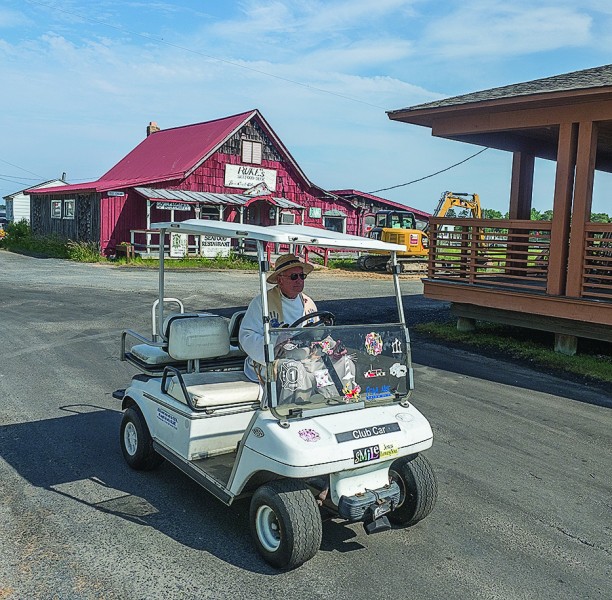
Pastor Rick Edmund runs errands via golf cart, as do many other Smith Islanders. Photo: Dave Harp, Bay Journal
Landon’s move to Smith is an opportunity to increase the island’s younger population; he’ll bring his two daughters, 12 and 15, and his 19-year-old son will visit often. As for continuing Edmund’s role as island ambassador and talking about sea-level rise and erosion, Landon said he’s comfortable with that, too.
“You just have to keep it in front of you, and know it is a reality,” he said of the island’s shrinking shoreline. “Any pastor for the church would advocate for the community he’s in. I certainly look forward to being a part of that.”
On one of his last Sundays, Edmund wore his customary white vestments and a stole decorated with the handprints of his children and grandchildren. He balanced a plate of meatballs and potato salad from the Ewell graduation reception as he climbed into Ronnie Corbin’s skiff and ate it as he headed down the channel to Tylerton for his second service.
There had been no time for breakfast; there would be no time for lunch. A golf cart took him to the church; it’s a block away, but there was no time to walk.
A half-hour into the service, a woman asked for prayers for a relative in the throes of heroin addiction; Edmund shared the story of his own cousin, who died of an overdose. He read scripture and led hymns. And he told parishioners about the life of Roy Johnsen, a name they might not know, a come-here who loved it so much he wanted to stay forever. And, he told the congregation, he knew exactly what that felt like.
“I’ve lived here longer than I’ve lived anywhere else in my life. This is my home, too.”
Bay Journal is published by Bay Journal Media, a 501(c)(3) nonprofit, to inform the public about issues that affect the Chesapeake Bay. A print edition is published monthly and is distributed free of charge. News, features and commentary are available free online at bayjournal.com. MarylandReporter.com is partnering with the Bay Journal by publishing one of its articles every Friday.
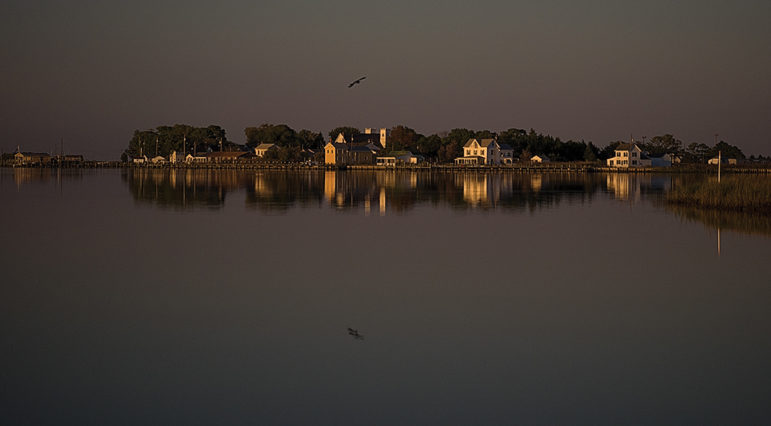
The village of Tylerton on Smith Island. Photo: Dave Harp, Bay Journal

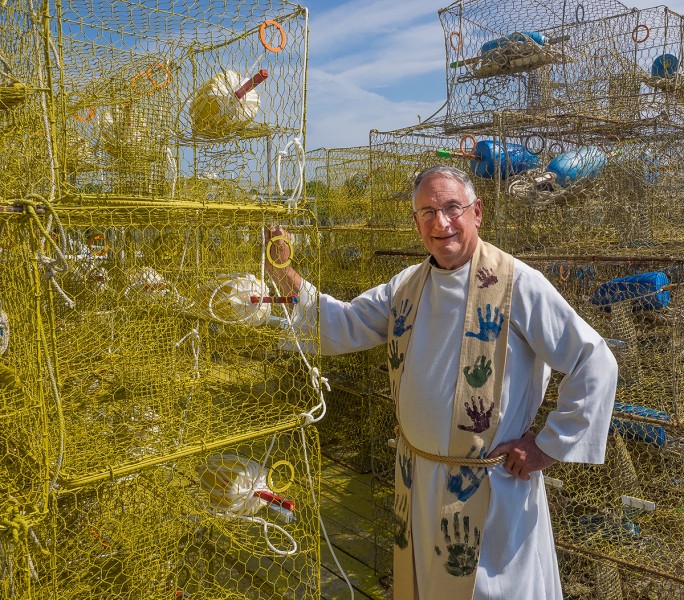

Recent Comments